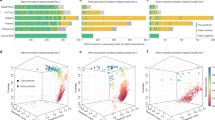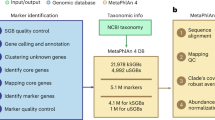Abstract
To quantify known and unknown microorganisms at species-level resolution using shotgun sequencing data, we developed a method that establishes metagenomic operational taxonomic units (mOTUs) based on single-copy phylogenetic marker genes. Applied to 252 human fecal samples, the method revealed that on average 43% of the species abundance and 58% of the richness cannot be captured by current reference genome–based methods. An implementation of the method is available at http://www.bork.embl.de/software/mOTU/.
This is a preview of subscription content, access via your institution
Access options
Subscribe to this journal
Receive 12 print issues and online access
$259.00 per year
only $21.58 per issue
Buy this article
- Purchase on Springer Link
- Instant access to full article PDF
Prices may be subject to local taxes which are calculated during checkout



Similar content being viewed by others
References
Klappenbach, J.A., Saxman, P.R., Cole, J.R. & Schmidt, T.M. Nucleic Acids Res. 29, 181–184 (2001).
Engelbrektson, A. et al. ISME J. 4, 642–647 (2010).
Claesson, M.J. et al. Nucleic Acids Res. 38, e200 (2010).
Gevers, D. et al. Nat. Rev. Microbiol. 3, 733–739 (2005).
Arumugam, M. et al. Nature 473, 174–180 (2011).
Liu, B., Gibbons, T., Ghodsi, M., Treangen, T. & Pop, M. BMC Genomics 12 (suppl. 2), S4 (2011).
Segata, N. et al. Nat. Methods 9, 811–814 (2012).
Ciccarelli, F. et al. Science 311, 1283–1287 (2006).
Sorek, R. et al. Science 318, 1449–1452 (2007).
von Mering, C. et al. Science 315, 1126–1130 (2007).
Mende, D.R., Sunagawa, S., Zeller, G. & Bork, P. Nat. Methods 10, 881–884 (2013).
Qin, J. et al. Nature 464, 59–65 (2010).
The Human Microbiome Project Consortium. Nature 486, 215–221 (2012).
Nelson, K.E. et al. Science 328, 994–999 (2010).
Walker, A.W. et al. ISME J. 5, 220–230 (2011).
Mondot, S. et al. Inflamm. Bowel Dis. 17, 185–192 (2011).
Schloissnig, S. et al. Nature 493, 45–50 (2013).
Turnbaugh, P.J. et al. Nature 457, 480–484 (2009).
Rajilic-Stojanovic, M., Heilig, H.G., Tims, S., Zoetendal, E.G. & de Vos, W.M. Environ. Microbiol. 15, 1146–1159 (2012).
Manichanh, C., Borruel, N., Casellas, F. & Guarner, F. Nat. Rev. Gastroenterol. Hepatol. 9, 599–608 (2012).
Rajilic-Stojanovic, M., Shanahan, F., Guarner, F. & de Vos, W.M. Inflamm. Bowel Dis. 19, 481–488 (2013).
Png, C.W. et al. Am. J. Gastroenterol. 105, 2420–2428 (2010).
Qin, J. et al. Nature 490, 55–60 (2012).
Forslund, K. et al. Genome Res. 23, 1163–1169 (2013).
Kultima, J.R. et al. PLoS ONE 7, e47656 (2012).
Eddy, S.R. PLoS Comput. Biol. 7, e1002195 (2011).
Muller, J., Creevey, C.J., Thompson, J.D., Arendt, D. & Bork, P. Bioinformatics 26, 263–265 (2010).
Powell, S. et al. Nucleic Acids Res. 40, D284–D289 (2012).
Mende, D.R. et al. PLoS ONE 7, e31386 (2012).
Edgar, R.C. Bioinformatics 26, 2460–2461 (2010).
Stamatakis, A. Bioinformatics 22, 2688–2690 (2006).
Stamatakis, A. & Aberer, A. in Proceedings of the 2013 IEEE 27th International Symposium on Parallel and Distributed Processing 1195–1204 (2013).
Berger, S.A. & Stamatakis, A. Bioinformatics 27, 2068–2075 (2011).
Berger, S.A., Krompass, D. & Stamatakis, A. Syst. Biol. 60, 291–302 (2011).
Letunic, I. & Bork, P. Bioinformatics 23, 127–128 (2007).
Acknowledgements
We thank members of the European Molecular Biology Laboratory Information Technologies core facility and Y. Yuan for managing the high-performance computing resources and the members of the Bork group for fruitful discussions. This work was supported by funding from European Molecular Biology Laboratory, the European Community's Seventh Framework Programme via the MetaHIT (HEALTH-F4-2007-201052) and International Human Microbiome Standards, (HEALTH-F4-2010-261376) grants, The Novo Nordisk Foundation, The Lundbeck Foundation, institutional funding by the Heidelberg Institute for Theoretical Studies and Deutsche Forschungsgemeinschaft grants STA 860/2 and STA 860/3, the Metagenopolis ANR-11-DPBS-0001 grant, and the European Research Council Advanced Grants (MicrobesInside and CancerBiome grant agreement numbers 250172 and 268985 to W.M.d.V. and P.B., respectively).
Author information
Authors and Affiliations
Contributions
P.B. and S.S. conceived the study, S.S., D.R.M., G.Z., F.I.-C., S.A.B., M.A., J.T. and A.S. designed and performed the analyses, S.S., D.R.M., G.Z., J.R.K., L.P.C. and J.L. developed and implemented the program, O.P., F.G., J.D. and J.W. provided data, S.S., D.R.M., G.Z. and P.B. wrote the manuscript, and M.A., J.T., H.B.N., S.R., O.P., F.G., W.M.d.V., S.D.E. and A.S. gave conceptual advice and revised the manuscript.
Corresponding author
Ethics declarations
Competing interests
The authors declare no competing financial interests.
Supplementary information
Supplementary Text and Figures
Supplementary Figures 1–8, and Supplementary Tables 4, 5 and 7 (PDF 2053 kb)
Supplementary Table 1
Prokaryotic reference genomes used in this study. (XLSX 159 kb)
Supplementary Table 2
Summary of benchmark results for speed and accuracy of marker gene identification. (XLSX 13 kb)
Supplementary Table 3
Metagenomic data sets used in this study. (XLSX 21 kb)
Supplementary Table 6
Summary of mOTU linkage groups with taxonomic annotations. (XLSX 67 kb)
Supplementary Software
mOTU profiling tool. (ZIP 86115 kb)
Rights and permissions
About this article
Cite this article
Sunagawa, S., Mende, D., Zeller, G. et al. Metagenomic species profiling using universal phylogenetic marker genes. Nat Methods 10, 1196–1199 (2013). https://doi.org/10.1038/nmeth.2693
Received:
Accepted:
Published:
Issue Date:
DOI: https://doi.org/10.1038/nmeth.2693
This article is cited by
-
Multi-omic integration of microbiome data for identifying disease-associated modules
Nature Communications (2024)
-
Biological big-data sources, problems of storage, computational issues, and applications: a comprehensive review
Knowledge and Information Systems (2024)
-
The gut microbiome in social anxiety disorder: evidence of altered composition and function
Translational Psychiatry (2023)
-
Oxygen respiration and polysaccharide degradation by a sulfate-reducing acidobacterium
Nature Communications (2023)
-
MetaCRS: unsupervised clustering of contigs with the recursive strategy of reducing metagenomic dataset’s complexity
BMC Bioinformatics (2022)



